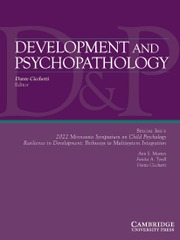Article contents
Associations of neighborhood threat and deprivation with psychopathology: Uncovering neural mechanisms
Published online by Cambridge University Press: 30 June 2025
Abstract
Assessing dimensions of neighborhoods could aid identification of contextual features that influence psychopathology in children and contribute to uncovering mechanisms underlying these associations.
The ABCD sample included 8,339 participants aged 9–10 from 21 U.S. sites. Mixed effect and structural equation models estimated associations of self-reported neighborhood threat/safety and county-level neighborhood threat (i.e., crime) and tract-level deprivation with psychopathology symptoms and indirect effects. Hypothesized mechanisms included emotion processing (adaptation to emotional conflict, task-active ROIs for emotional n-back) and cognition (EF and task-active ROIs for the stop-signal task); exploratory analyses included neural function (of amygdala to network and within-network resting state connectivity).
Associations of neighborhood deprivation and all symptoms were mediated by EF; links with psychotic-like experiences (PLEs) were mediated by retrosplenial temporal and dorsal attention within-network connectivity. In contrast, neighborhood threat was associated with attention difficulties, internalizing problems, and PLEs uniquely via default mode within-network connectivity; with attention difficulties, externalizing symptoms, and PLEs through amygdala-dorsal attention within-network connectivity, with PLEs and externalizing symptoms through visual within-network connectivity; with PLEs and attention difficulties through amygdala-sensorimotor connectivity, and with PLEs through amygdala-salience network connectivity.
Neighborhood deprivation and threat predicted symptoms through distinct neural and cognitive pathways, with implications for prevention and intervention efforts at contextual levels.
Information
- Type
- Regular Article
- Information
- Copyright
- © The Author(s), 2025. Published by Cambridge University Press
References
- 2
- Cited by


